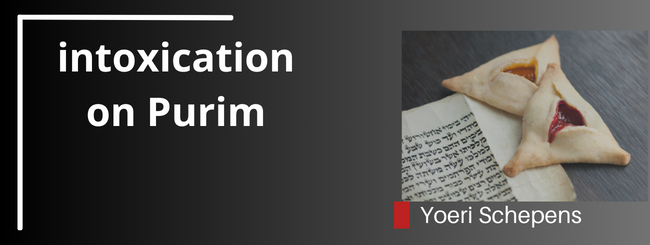It is often said that the point of the story is that one should get drunk until one is “dead to the world.” Let’s take a look at the next sources:
Rava said: A person is obligated to become “intoxicated” on Purim until he cannot distinguish between “cursed is Haman” and “blessed is Mordechai”.
If you are looking for excuses to get drunk you might be tempted to use this verse to do so, but what is it telling us? What is really meant by intoxication? How could The Ribono Shel Olam ever ask anyone to lose his sobriety to the level of not even knowing the difference between a curse and a blessing?
The short answer is He didn’t and He wouldn’t.
So what does He mean?
The Sages taught:
Four entered “the orchard” [PARDES], and they are Ben Azzai; ben Zoma; Acher [“the other”, Elisha ben Avuya]; and Rabbi Akiva… Ben Azzai glimpsed and died. And concerning him the verse states: “Precious in the eyes of the Lord is the death of His pious ones” (Psalms 116:15). Ben Zoma glimpsed and was “harmed”. And concerning him the verse states: “Have you found honey? Eat as much as is sufficient for you, lest you become full from it and vomit it” (Proverbs 25:16). Acher “cut the saplings”. Rabbi Akiva came out in peace.
Talmud, Chagigah 14b
Clearly, death is not a literal thing in this tractate, one can reach such high levels that he is considered dead in this shallow world of Asiyah, a world of perception through 5 senses that merely show an image in our minds, they entered PaRDeS meaning, Intoxicating themselves with the deeper knowledge of Torah.
PaRDeS levels explained:
Peshat (simple)
Remez (allusory)
Drash(allegorical)
Sod (secret) (and Sod in Sod)
The Introduction to the Arizal’s Sha’ar HaMitzvot says:
With regards to learning Torah, which is one of the 248 positive mitzvot, if a person did not fulfill this mitzvah in the Pardes of Torah – which stands for peshat, remez, drash, sod – according to what each person can achieve on their level, to grapple with [to understand], and to find a Rav who will teach him. If he didn’t do so, he has not fulfilled the mitzvah of Torah study – which is greater than all mitzvot – and he will need to reincarnate until he grapples with all four levels of Pardes.
In the next verses, we find that Torah Study (in depth) is like a drug an elixir or an Antidote:
The Sages taught: “And you shall place [vesamtem] these words of Mine in your hearts” (Deuteronomy 11:18). Read this as though it stated sam tam, a perfect elixir… too the Holy One, Blessed be He, said to Israel: My children, I created an evil inclination [the poison], and I created Torah as its antidote. If you are engaged in Torah study you will not be given over into the hand of the evil inclination, as stated: “If you do well, shall it not be lifted up?” (Genesis 4:7)
Talmud, Kiddushin 30b
So the intoxication is a higher state of consciousness, but how does that explain ” not being able to distinguish between “cursed is Haman” and “blessed is Mordechai ”?
That brings us to Gematria which again is a statement that one must try to study Torah at the highest capacity level possible.
The Gematria:
Blessed is Mordechai/Baruch Mordechai = 502 Cursed is Haman/Arur Haman. = 502
That’s what is meant by “until he cannot distinguish between “cursed is Haman” and “blessed is Mordechai”.
The intoxication is nothing else but the elixir/ antidote called Torah Nothing in Torah is coincidental and equal gematria values can tell us a lot about the deeper secrets.
Some other examples of equal Gematria between Good/Tov and Evil/Ra are:
RA TOV
Nachash = 358 = Mashiach
Haman = 95 = Daniel
And there are numerous other combinations to be intoxicated with.
The Good which is the right column, stabilises the evil of the left column finding its balance in the middle
Like Chesed(right) Gevurah(left) Tiferet(middle) to a perfect Harmony.
The Megillah is full of Kabbalah, written in 10 chapters each chapter represents and even names the sefirot, starting from the crown Keter, all the way down to Malchut/Nukva. As we all know Hashem is never mentioned in the Megillah but the profoundness of this work is full of His wonders. Purim means so much more than grown men wasting their divine behavior on getting drunk or wasted.
Remember what Shlomo HaMelech said:
Mishlei 20:1 The [imbiber of] wine is a scorner; he roars, “Strong drink!” And whoever strays with it will not become wise.
23:29 Who cries, “Woe!” Who, “Alas!” He who has quarrels. He who talks too much. Who has wounds without cause? Who has bloodshot eyes? Those who sit late over wine, those who come to search for mixed wine. 31 Do not look at wine when it is red; when he puts his eye on the cup, it goes smoothly. 32 Ultimately, it will bite like a serpent, and sting like a viper. 33 Your eyes will see strange women, and your heart will speak confusedly. 34 And you shall be like one lying in the midst of the sea and like one lying at the top of a mast. 35″They struck me but I did not become ill; they beat me but I did not know it. When will I awaken? I will continue; I will seek it again.”
Intoxicate yourselves with Torah, not wine!!!!
By Yoeri Schepens
Sources: Talmud, Megillah 7b, Talmud, Chagigah 14b, Talmud, Kiddushin 30b, Mishlei 20:1 23:29-35
© Copyright, all rights reserved. If you enjoyed this article, we encourage you to distribute it further.
Our blogs may contain texts/ quotes/references/links of
Mechon-Mamre.org, Aish.com, Sefaria.org, Chabad.org AskNoah.org
that contain copyrights and which we may use with there permission.
